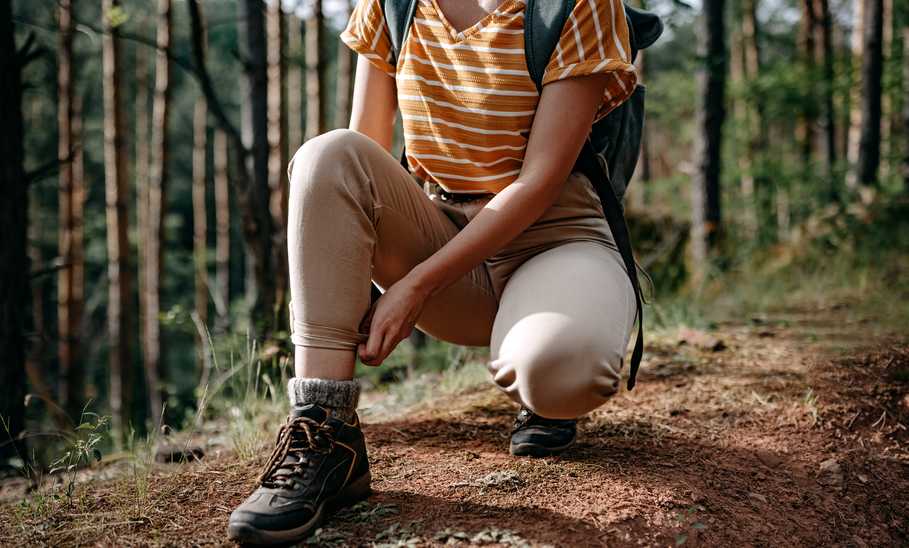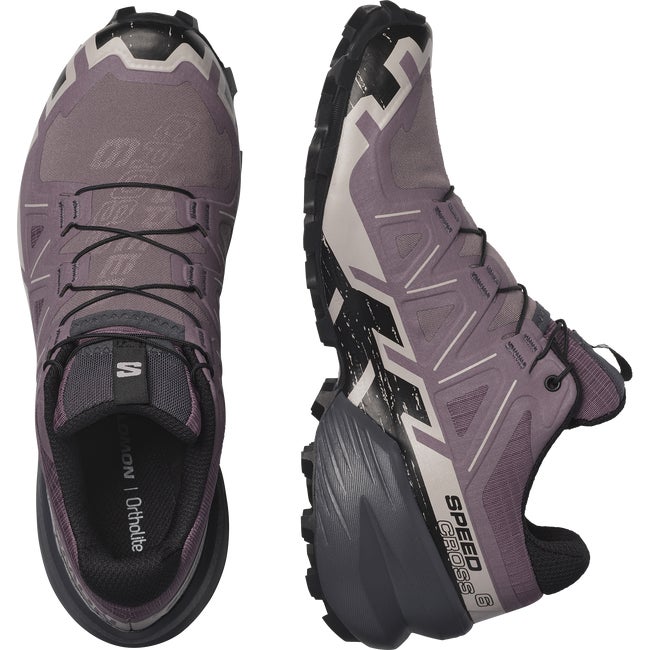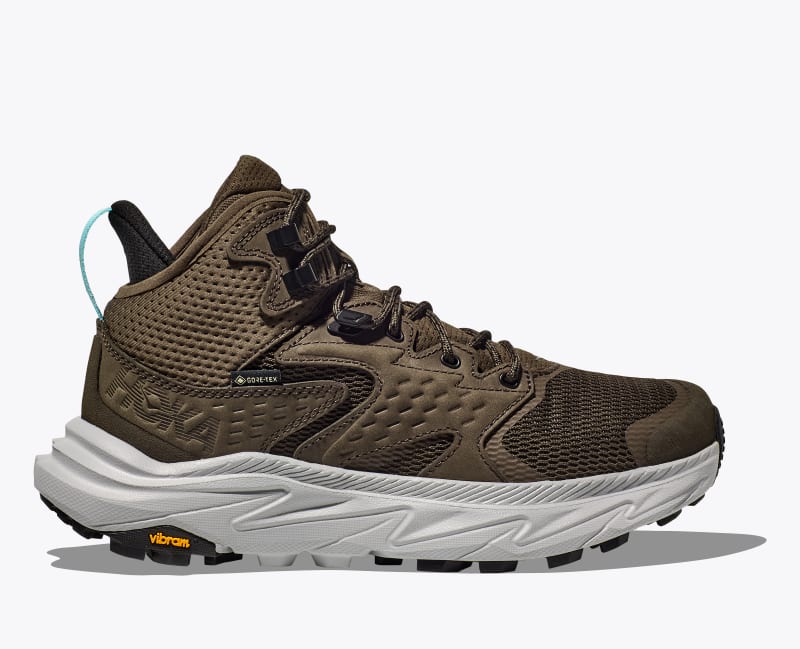- Sizes: 5 to 12, Medium and Wide width
- Weight: 13.57 ounces
- Waterproof: Yes
- Price on publish: $150
Eleven of the Best Hiking Boots for Women Hitting the Trails

Our evaluations and opinions are not influenced by our advertising relationships, but we may earn a commission from our partners’ links. This content is created by TIME Stamped, under TIME’s direction and produced in accordance with TIME’s editorial guidelines and overseen by TIME’s editorial staff. Learn more about it.
Spending time outside can be beneficial to both our mental and physical health. Hiking is a wonderful way to reap these rewards while also experiencing the diverse beauty that nature has to offer. It’s important, though, to make sure that you have a quality pair of boots to protect and support your feet—and help keep you injury and pain free no matter how far or long you hike.
To help narrow down the plethora of choices, I contacted the American Hiking Guides Association (AHGA), which offers training programs and certifications for hiking and backpacking guides and mountain leaders in the United States. They are also an aspirant member country under the Union of International Mountain Leader Associations, the international governing body for mountain leaders across the world.
I talked to a couple of AHGA’s board members—who are also avid hikers—about their favorite hiking boots and advice on how to choose your own favorite pair. Deborah E. Padilla, who collaborates on organizing AHGA’s hiking and backpacking guide training programs, owns numerous pairs (some even multiples of the same style) of Oboz brand hiking boots because they fit her narrow feet well.
Elise Grandizio, another board member and AHGA certified hiking guide, leads curated trips for women through her company Hike Explore Recharge (HER) and said she probably owns 16 to 20 pairs of boots. “I have eight pairs here in Pennsylvania and probably the same amount in Arizona, plus a couple pairs in the car,” she said.
With the help of both of them, I curated the following list of the best hiking boots for a range of situations, preferences, and conditions.

If you’ve ever paid attention to what other hikers have on their feet, you’ve probably noticed quite a few Merrell Moabs. Well known amongst the outdoor community for their comfort, performance, low weight, and affordability, the Merrell Moab has long been the hiking boot of choice for a wide range of people, especially new hikers. Made for rugged terrain, the Moab contains an air cushion for shock absorption, ankle support, a contoured footbed, and mesh panels for breathability (so your feet don’t get sweaty). While they perform really well on a variety of surfaces, the traction, in my experience, isn't quite as good on anything with lots of mud and snow.
In addition to being well known and respected, these Merrell hiking boots are comfortable, supportive, durable, and suitable for a range of conditions.

Made with a women’s specific EVA midsole and durable outsole with tons of traction, the Oboz Sapphire Mid B-Dry Hiking Boot provides exceptional comfort and support in a breathable, waterproof package. They’re Padilla’s favorite pair. They fit her narrow feet well, making her feel more secure when out on the mountain. And they have good ankle support.
Padilla has put thousands of miles on each pair she’s owned and has used them in various conditions including hiking Mount Washington and Harriman State Park. “I am a creature of habit and buy the same pair when they wear out,” she said. “So far, they’ve never proved me wrong.”
This is a supportive, comfortable, and waterproof hiking boot suitable for a variety of conditions.

Grandizio’s go-to hiking boot is actually one of the best trail running shoes. Like all of the Salomon line, they have a wider toe box with a narrower fit through the heel and sides, which works well for her feet. “I don't have a wide foot,” she explained, “but I do have a bunion, and that throws an interesting spin into finding boots that fit.” Wide boots slide around on her, but narrower ones irritate the bunion. Salomon provides the solution to her fit puzzle.
“Plus, these have really nice grips on them. If you’re doing anything out of the ordinary (such as bouldering), they just really grip really, really well,” she said.
This option from Salomon is a lightweight trail running shoe that provides exceptional grip on rock surfaces and in muddy conditions.

For colder and wintery conditions, Padilla uses these Oboz waterproof boots. “They have 3M™ Thinsulate synthetic fibers for insulation that keep me extremely warm and dry,” she explained. “And they provide ankle support—especially in technical conditions.”
These feature a cold-weather specific rubber outsole that provides excellent grip in snow and other assorted wintery precipitation, plus a Mylar layer under the insole that reflects heat back to your feet.
These insulated, waterproof hiking boots provide excellent grip and ankle support, especially in winter conditions.

For desert hiking where sand has the tendency to make its way into your boot, Grandizio turns to her Salomon S/Lab Pulsars. They have a sock-type extension that fits close to your ankle, eliminating the need for a gaiter, she explained. The strategic cushioning in the mid and insole, and secure heel construction, provides comfortable support over a variety of trails. They’re also extremely lightweight.
This is a nimble and supportive trail running/hiking shoe with a secure mesh sock fit that keeps trail dirt and sand from getting inside your shoe.

The first true pair of hiking boots I ever owned were these Lowa Renegade GTX Mids. They have a classic leather upper coupled with a GORE-TEX lining. The cushioning around the ankle and tongue provides both support and comfort, and their Climate Control System keeps them breathable. They’re also comfortable enough to wear on a multi-day backpacking adventure. The Vibram® outsole provides adequate grip in most conditions though when traversing wet, smooth boulders, they’re a bit too slippery (which I discovered while trekking through a jungle).
Mine died a slow death during a three-week trek through the Borneo Rainforest, after which I could never get the jungle mud off of them.
This leather hiking boot from Lowa is waterproof, supportive, and suitable for backpacking and trekking.

Grandizio said she uses these as her winter hiking boots. The mid height provides support while not hitting her Achilles (which can be painful), and the waterproof GORE-TEX construction means these are exceptionally waterproof. The women’s specific design offers a soft cuff around the ankle and an anatomical insole and midsole construction for added stability and support. And, the grippy outsole keeps your feet on the ground over mixed and alpine terrains.
This option is a supportive, waterproof boot with a sole that provides excellent grip on wet surfaces as well as rocky terrain.

Like all of HOKA’s footwear, the Anacapa carries the American Podiatric Medical Association’s (APMA) Seal of Acceptance, which recognizes products that have been found beneficial to foot health. They feature a symmetrical, protective cushioned bed that provides responsive “toe-off” (or bounce) when you want to pick up the speed, and a Vibram® Megagrip outsole so uneven rocky terrain won’t slow you down.
Hoka’s are definitely a shoe you need to test out before embarking on a long hike. They have a wider footprint compared to some others which, in my experience, can cause you to literally trip over your own feet if you’re not accustomed. (I could also just be exceptionally clumsy.)
Approved by the American Podiatric Medical Association, this Hoka option is a highly cushioned, grippy hiking boot made with sustainable and recycled materials.

Specifically designed for multi-day expeditions and tough conditions, the Salomon Quest is what I wore while trekking in the Karakoram and Pamir Mountain ranges. Even though this option is on the heavier side, I like the stability and support they provide, especially around the ankles. I have argumentative knees and these help to keep them quiet while I’m navigating tricky mountain terrain. And the soles (which are quite substantial) are incredibly grippy, so I don’t have to worry much about slipping or sliding.
These are overkill for anyone who sticks mainly to well-maintained trails, but if you’re striking out into less traveled areas, they’re an excellent choice.
This is a supportive, stable, and grippy hiking boot for mountain adventures and sketchy terrain.

Altra Lone Peaks are known for their wide toe boxes and flat, spacious foot beds. If you have wider feet and find most hiking boots too narrow, these are a great option. This updated version features a modern, almost fashionable design that also provides ample support when out on the trail.
These boots are a versatile option with a modern design for people with wide feet.
Delivering comfort and traction whether you’re out on the trail or not, Columbia’s Trailstorm Peak is a versatile, budget-friendly option for beginner hikers. As one reviewer pointed out, “The real star is how stylish they are! They're wide enough to be comfortable but narrow enough to not be bulbous like a lot of hiking shoes tend to look.”
The single density foam midsole gives them cushion and stability while the Adapt Trax™ outsole keeps your feet on the ground where they should be in both wet and dry conditions.
“I have friends who are beginner hikers that have used this boot and reported that they are inexpensive, have good tread, and fit securely,” said Padilla.
This is an excellent, versatile, and budget-friendly option for beginner hikers who don’t want a “bulky” hiking boot silhouette.
I talked to experts from the American Hiking Guides Association (AHGA) as well as drawing from my own experience. I also extensively researched online reviews to come up with selections that consistently received high marks in durability, comfort, support, weight, and traction.
There are a lot of options available online from a variety of retailers including Backcountry, Dick’s Sporting Goods, Columbia, or most anywhere that also sells walking shoes and winter boots. When deciding which hiking boots to purchase, consider the following:
If you’re planning on sticking mainly to well-maintained trails, look for a lightweight hiking boot or even trail running shoes. For long hikes and backpacking expeditions, you’ll need something a bit more substantial that offers extended durability and support.
Whether you want boots to fit with extra room or not depends on the socks you plan to wear as well as the climate you’re hiking in, Grandizio told me. Which is part of the reason she owns so many pairs—she has some in more than one size.
“First, I always wear a wool sock,” she told me. Wool socks come in a variety of thicknesses. SmartWool, for instance, makes a lightweight wool sock that will fit differently than a heavier one. Grandizio said, “It might be the difference of a half size.”
In general, she recommends a boot fit snugly but not too tight. If your foot moves up and down, you’ll develop blisters. Also, don’t forget that hiking footwear needs to be broken in, even all of the non-leather versions included here. Boots will mold to your feet the more you wear them, often becoming more comfortable over time, so don’t embark on a long multi-day hike in a brand new pair of boots.
If you know you’re going to use your boots in snowy or rainy conditions you’ll likely want a full waterproof style to keep your feet dry. These won’t be as breathable as a water-resistant boot (though all waterproof boots should feature some kind of breathable inserts and/or features). The lack of breathability means your feet could get sweaty when hiking in warmer temperatures.
Winter conditions not only call for the best winter jackets and coats for women but also boots. Most brands offer a winter style of hiking boot that will be waterproof and contain insulation to protect your feet from the cold.
Keep your boots clean and dry, rinsing them off with a hose then scrubbing with a vegetable brush after an especially mucky or muddy hike. Never dry your boots near a heater as that can crack any leather parts and/or melt the soles. All boots will dry faster if you stuff them with crumpled up newspaper which will absorb the moisture.
If you’ve been out in the rain, remove the insoles and allow them to air dry. If you’ve trekked through salt water, rinse them off as soon as possible because the salt will rust any metal parts, like eyelets.
While Grandizio says she basically refers to everything as a hiking boot, what differentiates them from hiking shoes is that they have a mid or higher ankle height, which many people need for the support. “I find for myself (being petite in stature) that a heavy boot that comes up high doesn't serve me as well,” she said.
“But definitely if you're new out on the trails, you really should have that ankle support,” she added.
Many hiking boots are just as suitable for walking as they are for trekking and hiking. The heavier boots made for alpine adventures will definitely be overkill if you’re just strolling about town, though they’re unlikely to cause any kind of damage or discomfort. If you’re backpacking across multiple countries, your hiking boots are very likely the only footwear you have with you (aside from a pair of shower flip flops), so wearing them while walking will be your best option anyway.
Grandizio says she’s been out on the trail with people in sneakers and flip flops. “And I just don't think it's safe because you can twist an ankle,” she said. There’s a difference, though, between sneakers made for running on pavement and actual trail runners,which can work in certain hiking conditions. But she added, “You're definitely not going to wear trail runners out on some rugged trail.”
“Sneakers are a little flatter on the bottom, and their treads are not as deep,” Grandizio explained. This means that if you encounter a slippery situation such as ascending a rocky surface, a sneaker won’t provide a good enough grip. Trail hiking boots are designed with deeper treads that provide more grip, as well as support for your feet.
Padilla doesn’t recommend hiking in sneakers either for all the same reasons. “Different terrain offers different risks,” she said, “and should be conducted at your own risk.” If you only have sneakers and want to do an easy hike, she suggests sticking to paved nature trails.
This depends somewhat on personal preference as well as on what type of hiking you’re doing. For alpine hikes or backpacking trips you’ll likely prefer a firmer shoe for the added support. Softer shoes, which tend to be lighter, work great on day hikes.
When carrying heavy packs, most people will benefit from a sturdy pair of boots that feature sufficient ankle support. Lighter weight boots and hiking shoes likely won’t provide a solid and substantial enough base nor enough cushioning to help offset the feel of carrying a great deal of weight. Boots designed for this purpose usually have stiffer midsoles and ample structure to prevent your feet from feeling every pebble, root, and uneven surface under them; the added weight of your pack can sometimes make you more susceptible to obstacles under your feet (because of, well, gravity).
No matter what shoe or boot you decide to go with, it’s important to try it out on short trails while wearing your fully loaded pack before embarking on a multi-day trip.
The information presented here is created by TIME Stamped and overseen by TIME editorial staff. To learn more, see our About Us page.



